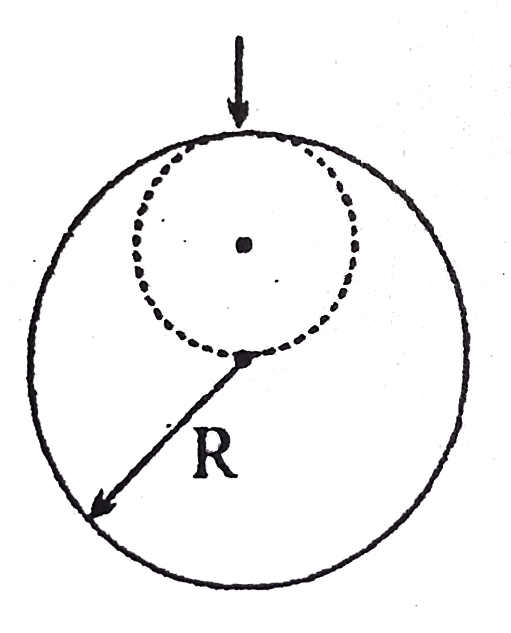A spherical hole of radius R/2 is excavated from the asteroid of mass M as shown in the figure the gravitational acceleration at a point on the surface of the asteroid just above the excavation is

GMR2
GM2R2
GM8R2
7GM8R2
The correct Answer is:B
Step by step video, text & image solution for A spherical hole of radius R//2 is excavated from the asteroid of mass M as shown in the figure the gravitational acceleration at a point on the surface of the asteroid just above the excavation is by Physics experts to help you in doubts & scoring excellent marks in Class 12 exams.
Updated on:21/07/2023Topper's Solved these Questions
- GRAVITATIONBOOK - FIITJEECHAPTER - GRAVITATIONEXERCISE - Assigment problems (Objective) (level-I) Assertion & Reasoning type
2 Videos
- GRAVITATIONBOOK - FIITJEECHAPTER - GRAVITATIONEXERCISE - Assigment problems (Objective) (level-II)
20 Videos
- GRAVITATIONBOOK - FIITJEECHAPTER - GRAVITATIONEXERCISE - Assigment problems (Subjective) (level II & III)
15 Videos
- GMP ASSESMENTBOOK - FIITJEECHAPTER - GMP ASSESMENTEXERCISE - Numerical Based
61 Videos
- HEAT AND TEMPERATUREBOOK - FIITJEECHAPTER - HEAT AND TEMPERATUREEXERCISE - NUMERICAL BASES QUESTIONS
1 Videos
Similar Questions
STATEMENT-1 : Assuming sun to be a body of very large mass in comparison to all other planets, the angular momentum of all the planets about the sun remains conserved.
because
STATEMENT-2 : Gravitational force is always conservative.
View SolutionAn object is weighted at the North Pole by a beam balance and a spring balance, giving readings of WB and WS respectively. It is again weighed in the same manner at the equator, giving readings of W'B and W'S respectively. Assume that the acceleration due to gravity is the same everywhere and that the balance are quite sensitive, Choose the wrong option
View SolutionWhat is the gravitational potential energy of a particle of mass m kept at a distance x from the centre of a disc of mass M on its axis ? The radius of the disc is R.
View SolutionA cyclist is going in a straight line at a unifrom velocity 18km/h. The resistance force can be expressed as force kv2 where k=0.8 where velocity is in m/s and unit of force is newton. The mass of the cyclist with the bicycle is 100kg. Neglect the rolling resistance force. If the power of the cyclist during the ride is 10x watt, then what is x ?
View SolutionEnds of two wires A and B, having resistivityρA=3×105Ωm and ρB=6×10−5ωm of same cross section ara are pointed together to form a single wire. If the resistance of the joined wire does not change with temperature, then find the ratio of their lengths given that temperatue coefficient of resistitivy of wires A and B are α=4×10−5/∘C and α=−4×106/∘C . Assume that mechanical dimensions do not change with temperature.
View SolutionFrom a solid sphere of mass M and radius R, a spherical portion of radius R/2 is removed, as shown in the figure Taking gravitational potential V =0at r = oo, the potential at (G = gravitational constatn)
View SolutionThe condition for a uniform spherical mass m of a radius r to be a black hole is [G =gravitational constant and g=acceleration due to gravity]
View SolutionConsider two solid spherical asteriod of uniform density of mass M and radius R. In one asteroid a tunnel tof very small size of depth R is bored to the centre and in other asteroid a spherical into the cavities of both asteroids from the top most point P. If force experienced by particle is FI and FII

View SolutionA small asteroid is approaching a planet of mass M and radius R from a large distance. Initially its velocity (u) is along a tangent to the surface of the planet. It fall on the surface making an angle of 30^(2) with the vertical. Calculate u.
View SolutionAn asteroid was fast approaching the earth. Scientists fired a rocket which hit the asteroid at a distance of 5 R from the centre of the earth (R = radius of the earth). mmediately after the hit the asteroid’s velocity (V_(0)) was making an angle of theta=30^(@) with the line joining the centre of the earth to the asteroid. The asteroid just grazed past the surface of the earth. Find V_(0) [Mass of the earth = M]
View SolutionA spherical hole of radius R//2 is excavated from the asteroid of mass M as shown in the figure the gravitational acceleration at a point on the surface of the asteroid just above the excavation is
View Solution[" Two spherical asteroids have "],[" the same radius "R" .Asteroid "1],[" has mass "M" and asteroid "2" has "],[" mass "2M" .The two asteroids are "],[" released from rest with distance "],[" 10R between their centers.What "],[" is the relative speed of approach "],[" just before they collide? "]
View SolutionA body of mass m is placed at the centre of the spherical shell of radius R and mass M. The gravitation potential on the surface of the shell is
View SolutionA : Kepler's law cannot be used for asteroids and comets . R: Asteroids and comets do not revolve around sun under its gravitational force .
View Solution(a) What is the escape speed on a spherical asteroid whose radius is 700 km and whose gravitational acceleration at the surface is 4.5m/s2? (b) How far from the surface will a particle go if it leaves the asteroid's surface with a radial speed of 1000 m/s? (c) With what speed will an object hit the asteroid if it is dropped from 1000 km above the surface?
View SolutionThe condition for a uniform spherical mass m of radius r to be a black hole is .....
(G = gravitational constant and g = acceleration due to gravity)
View Solution
